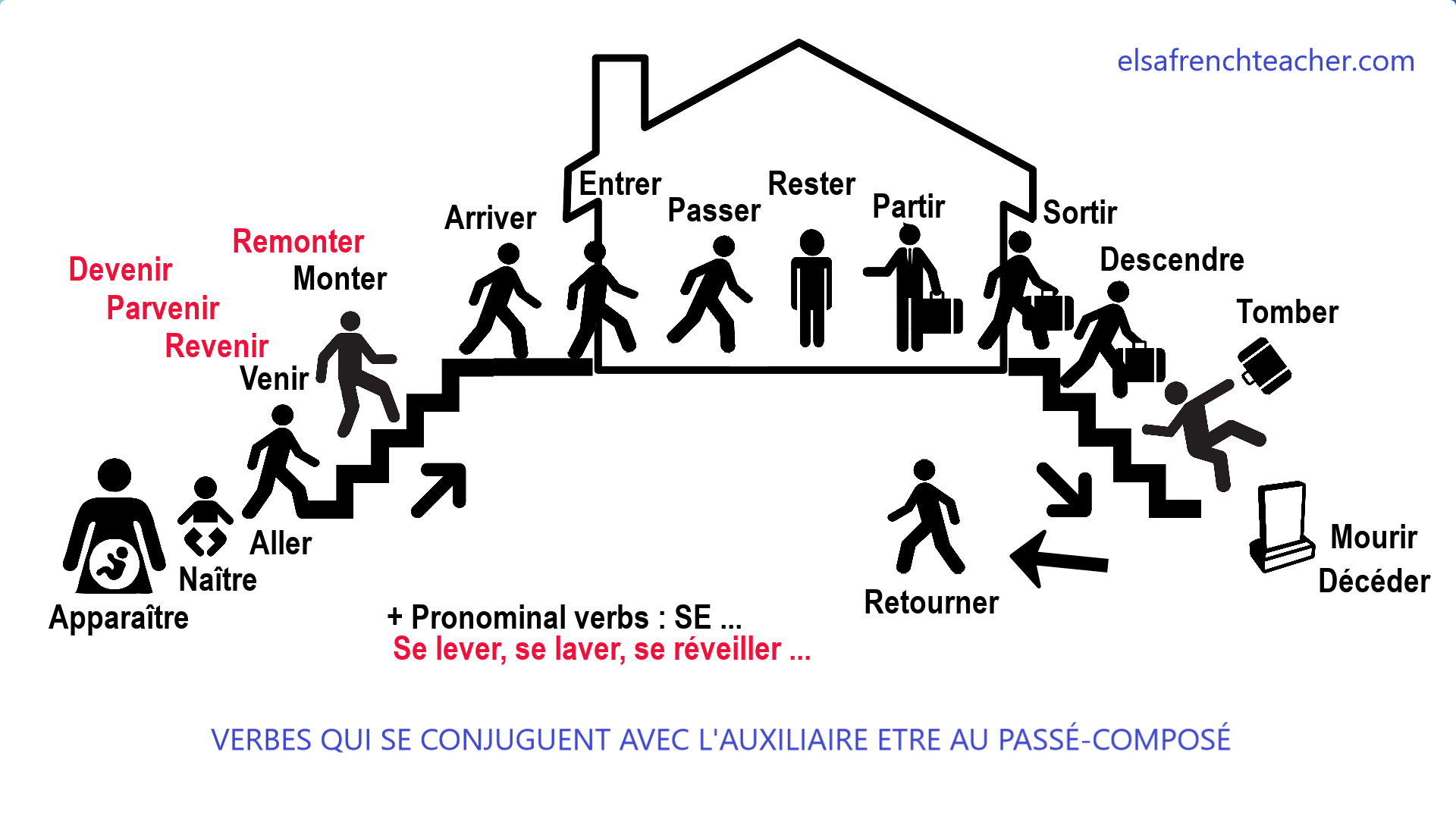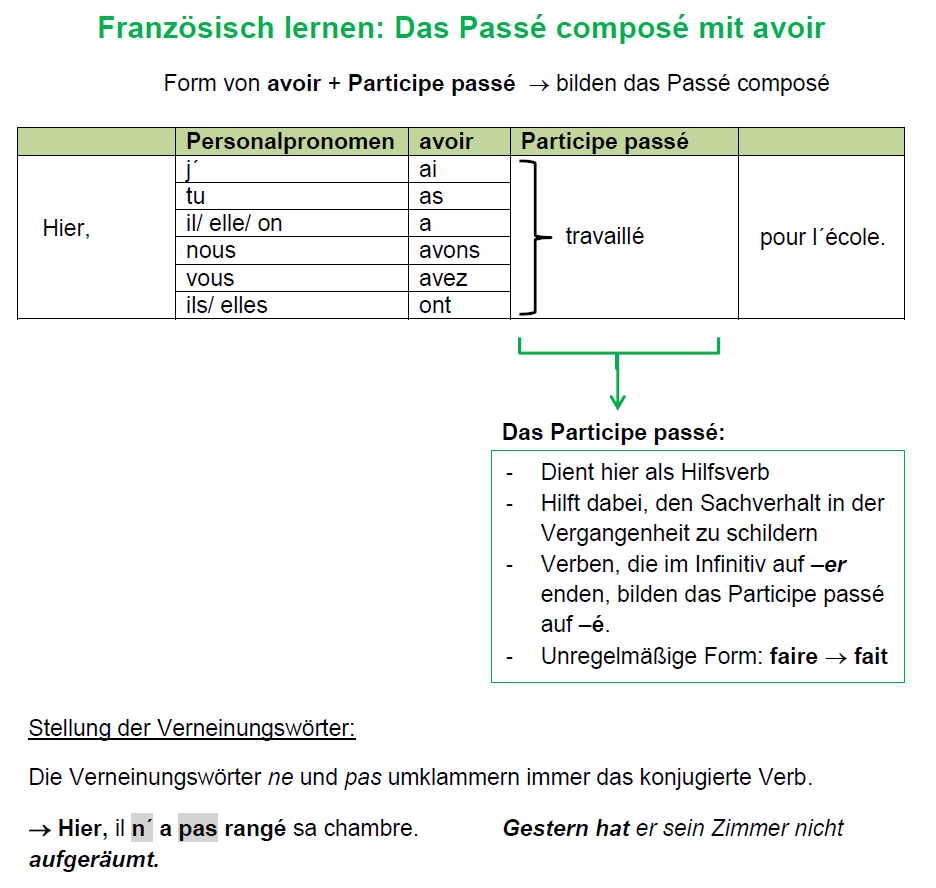
Francuski przy kawie język francuski Passé composé
To conjugate the passé composé we use the present tense of avoir or être as an auxiliary verb, followed by the past participle (participe passé) of the main verb. In negative sentences, the past participle comes after the second part of the negation (pas). Example:

Reflexive Verben (II) im passé composé Einfach besser erklärt! YouTube
The vast majority of French verbs form the passé composé with avoir. This means that you'll conjugate avoir the way you normally would and then add the past participle, as in the previous example. Let's do one more together: Subject + avoir + past participle [+ additional details] Je + ai + acheté + des fleurs hier.

Passé Composé Verneinung einfach erklärt sofatutor YouTube
In le passé composé tense, pronominal verbs are always conjugated with the auxiliary verb être. The reflexive pronoun is placed before the auxiliary verb. se laver en Je me suis lavé Tu t'es lavé Il s'est lavé/elle s'est lavée Nous nous sommes lavés Vous vous êtes lavés Ils se sont lavés/elles se sont lavées se souvenir en Je me suis souvenu

Passe Compose Verneinung PDF Übungen Französisch
Passé composé mit être Verben der Bewegung und reflexive Verben bilden ihr passé composé mit dem Hilfsverb être. An die Präsensform von être wird dann das angeglichene participe passé angehängt. Bildung Das passé composé mit être wird genauso gebildet wie das passé composé mit avoir.

Les verbes réfléchis au futur composé Die Reflexivverben in der Zukunft mit ALLER YouTube
70 2.6K views 2 years ago Das Video zeigt dir die Grundlagen zur Verneinung im Passé composé. Es ist der vierte und letzte Teil der Passé composé-Videoreihe. Es wurde aufgenommen für Schülerinnen.

Tandembögen passé composé mit avoir und dessen Verneinung (A1+) Unterrichtsmaterial im Fach
The passé composé is a compound tense, meaning you need two components to conjugate a verb. A helping verb (être or avoir) conjugated in the present tense. The past participle (participe passé) of the verb you want to conjugate. Let's see how this works in practice! 1. Choose your helping verb/auxiliary verb

(part 3) Elsa French Teacher (2023)
Elision. Liaison. Aspirated h. Help:IPA/French. v. t. e. The passé composé ( pronounced [pase kɔ̃poze]; 'compound past') is a past tense in the modern French language. It is used to express an action that has been finished completely or incompletely at the time of speech, or at some (possibly unknown) time in the past.

Französisch Passé Composé Übersicht Unterrichtsmaterial im Fach Französisch Französisch
The passé composé corresponds mostly to the English simple past or the present perfect. The passé composé talks about specific actions that were completed in the past. In spoken French language, the passé composé is always used instead of the passé simple. We conjugate the passé composé using the auxiliary verbs avoir or être followed.

Pin on Französisch Sekundarstufe Unterrichtsmaterialien
Das passé composé ist eine zusammengesetzte Zeitform, das heißt es besteht aus einem Hilfsverb ( avoir oder être) und einem Partizip Perfekt. Als Hilfsverb benutzt man entweder avoir oder être im Präsens. Auf das Hilfsverb folgt dann das Vollverb im Partizip Perfekt, participe passé genannt.

Learn French Over The The Most Effective Learn French Method French language
Passé composé: Verwendung + Bildung + Verneinung. Die französische Vergangenheit (passé composé) ist nicht so leicht zu erklären, da es zwei Möglichkeiten gibt, diese auszudrücken. Zum einen verwendet man das hier beschriebene passé composé, und zum anderen das sogenannte Imparfait.

Französisch lernen Das Passé composé mit avoir
1 2 3 4 5 6 7 8 9 Share 6.1K views 10 years ago Das komplette Video findest du auf http://bit.ly/Xpfxo8 In diesem Video zeigen wir dir, wie du die Verneinung im Passé composé bilden kannst. Da.

Was beachten bei passé composé mit être ǀ Lernwerk TV
To form the past pariciples for verbs ending in -rir, remove the -rir from the infintive and replace with -ert.For example: Ouvrir (to open) -> j'ai ouvert I opened; Couvrir (to cover) -> j'ai couvert I covered; Découvrir (to discover) -> j'ai découvert I discovered; Souffrir (to suffer) -> j'ai souffert I suffered; Être verbs in the passé composé. In French, there is a list of.

Bei diesem Arbeitsblatt wird die Verneinung im Französischen behandelt. Dazu sind Sätze
Passé Composé - Verneinung einfach erklärt | sofatutor sofatutor: Französisch einfach erklärt 1.14K subscribers Subscribe 0 25 views 1 year ago Das Video in voller Länge findest du unter:.

Reflexive Verben im passé composé + Übungsaufgabe Französisch Grammatik [GRÜNDLICH ERKLÄRT
A pronominal verb is a verb which has a reflexive pronoun, that is, a pronoun referring back to its subject. These verbs are easily recognized by the pronoun se before the infinitive: se lever, se laver, se promener, etc. In the passé composé, pronominal verbs are conjugated with être as their auxiliary. Past participles of pronominal verbs.

INFOGRAPHIES sur la formation du PASSÉ COMPOSÉ et de l’IMPARFAIT Enseñanza de francés, French
3. Past Participle. The Passé Composé consists out of three parts. A Pronoun. Avoir or Être in the Present Tense. A Past Participle. Of these three elements, only the third is new. The first two you should already know. Here's a recap of the pronouns, and the conjugations of Avoir and Être as a refresher.

Teile der Verneinung ǀ Lernwerk TV
0:00 / 2:30 Französisch: Die Verneinung im Passé composé 6 | Französisch | Grammatik sofa Franzoesisch 1.7K subscribers Subscribe 37 9.7K views 10 years ago Komplettes Französisch-Video unter.